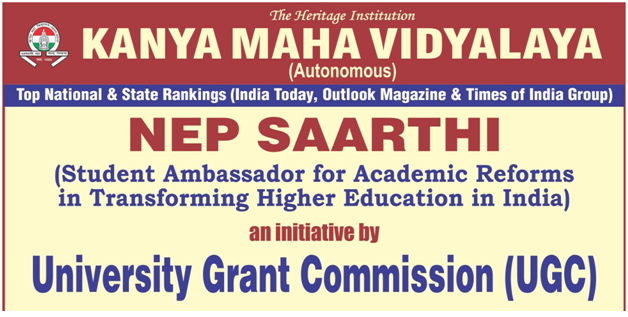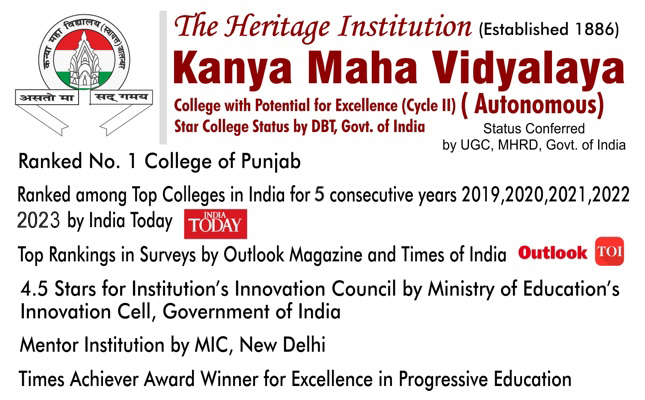Reception Desk : 0181-2296605, 2296606
For Admission related queries : 7009969253,9814406986
Email Id : kmvoffice1886@gmail.com,
kmvjalandhar@yahoo.com
- Only College under GNDU to be bestowed with FIST & CURIE grant by DST- Govt. of India
- Star College by DBT- Govt. of India
- Designated College with Potential for Excellence
- Accredited ‘A’ by UGC-NAAC
- Recognised as a Center of Excellence by RASCI, Government of India
- Best College in Punjab as per the Surveys
- Kaushal Kendra by UGC, MHRD, Govt. of India and first College under GNDU to have been granted Kaushal Kendra
Student Ambassador for Academic Reforms in Transforming Higher Education in India

-
Home
NEP SAARTHI Scheme – By UGC
To ensure that the vision of NEP 2020 reaches every educational institution, the University Grants Commission (UGC) has introduced the NEP SAARTHI initiative. The term “SAARTHI” stands for “Student Ambassador for Academic Reforms in Transforming Higher Education in India.”
Kanya Maha Vidyalaya, Jalandhar (KMV), has been recognized by the University Grants Commission (UGC) as an NEP SAARTHI institution for its exemplary implementation of the New Education Policy (NEP) 2020. This acknowledgment reflects KMV’s commitment to educational reforms and its proactive role in promoting the objectives of NEP 2020.
UGC approved three students of Kanya Maha Vidyalaya namely, Saniya, B.Sc. Medical, 3rd Year, Anushka Sharma, B.A., 3rd Year and Simran, B.Com. 3rd Year as NEP SAARTHIs.
Through this program, these selected students will take on the role of NEP SAARTHI — ambassadors who will:
- Promote awareness about the key aspects of NEP 2020
- Organize and participate in outreach activities
- Contribute ideas and suggestions for effective implementation of the New Education Policy (NEP) 2020
- Act as role models in adopting the policy’s reforms
This initiative offers students a unique chance to build leadership qualities, actively participate in shaping the future of education, and play a meaningful role in the country’s academic transformation.
Objectives:
- To create awareness and promote the initiatives of NEP 2020 among students on campus.
- To encourage and motivate students to actively participate in implementing the NEP 2020 initiatives.
- To establish a feedback mechanism for the UGC to understand the impact of NEP 2020 initiatives on students and address their concerns, if any.
-
About Us
Core Committee
Prof. (Dr.) Atima Sharma Dwivedi Principal, KMV Dr. Madhumeet Associate Professor, Head, Dept. of English Dean student welfare, Dean Languages,
Coordinator, NEP SAARTHI Dr. Monika Rani, Assistant Professor, PG Department of Mathematics Co-coordinator, NEP SAARTHI Dr Iqbal Singh, Assistant Professor, Department of Political Science Co-coordinator, NEP SAARTHI Student Team
Saniya, B.Sc. Medical, 3rd Year
NEP SAARTHI- Student Anushka Sharma, B.A., 3rd Year
NEP SAARTHI- Student Simran, B.Com. 3rd Year
NEP SAARTHI- Student -
About NEP 2020
The National Education Policy (NEP) 2020, introduced by the Government of India, marks the first major education reform of the 21st century, replacing the earlier policy formulated in 1986. This visionary policy is designed to make education more holistic, flexible, and multidisciplinary, aligning it with the demands of a rapidly changing world. At the same time, it seeks to preserve and promote India’s rich cultural heritage and traditional knowledge systems.
Key Highlights of NEP 2020
- New School Structure – 5+3+3+4
The 10+2 system has been replaced with a new 5+3+3+4 structure, emphasizing early childhood care and foundational literacy. - No More Rigid Streams
Students can choose subjects across streams. A science student can take up music or a commerce student can choose biology. - Multiple Entry and Exit Options in Higher Education
Students can pause and resume their education without losing credits. Certificates, diplomas, or degrees will be awarded depending on the duration completed. - Academic Bank of Credits (ABC)
It allows students to store academic credits digitally and use them across institutions. - Vocational Education
From Class 6 onwards, students will be introduced to vocational skills and internships. - Emphasis on Mother Tongue/Regional Language
Till Grade 5, education will be imparted in the home language or mother tongue to enhance understanding. - Holistic and Multidisciplinary Education
The focus is on overall development – academic, emotional, and practical skills. - Use of Technology and Digital Platforms
Integration of technology in teaching, learning, and assessment is a major priority.
Download link PDF file NEP 2020 HINDI
Download link PDF file NEP 2020 ENGLISH
- New School Structure – 5+3+3+4
-
Activity
Quick Links
Home
NEP SAARTHI Scheme – By UGC
To ensure that the vision of NEP 2020 reaches every educational institution, the University Grants Commission (UGC) has introduced the NEP SAARTHI initiative. The term “SAARTHI” stands for “Student Ambassador for Academic Reforms in Transforming Higher Education in India.”
Kanya Maha Vidyalaya, Jalandhar (KMV), has been recognized by the University Grants Commission (UGC) as an NEP SAARTHI institution for its exemplary implementation of the New Education Policy (NEP) 2020. This acknowledgment reflects KMV’s commitment to educational reforms and its proactive role in promoting the objectives of NEP 2020.
UGC approved three students of Kanya Maha Vidyalaya namely, Saniya, B.Sc. Medical, 3rd Year, Anushka Sharma, B.A., 3rd Year and Simran, B.Com. 3rd Year as NEP SAARTHIs.
Through this program, these selected students will take on the role of NEP SAARTHI — ambassadors who will:
- Promote awareness about the key aspects of NEP 2020
- Organize and participate in outreach activities
- Contribute ideas and suggestions for effective implementation of the New Education Policy (NEP) 2020
- Act as role models in adopting the policy’s reforms
This initiative offers students a unique chance to build leadership qualities, actively participate in shaping the future of education, and play a meaningful role in the country’s academic transformation.
Objectives:
- To create awareness and promote the initiatives of NEP 2020 among students on campus.
- To encourage and motivate students to actively participate in implementing the NEP 2020 initiatives.
- To establish a feedback mechanism for the UGC to understand the impact of NEP 2020 initiatives on students and address their concerns, if any.
About Us
Core Committee
| Prof. (Dr.) Atima Sharma Dwivedi | Principal, KMV |
| Dr. Madhumeet
Associate Professor, Head, Dept. of English Dean student welfare, Dean Languages, |
Coordinator, NEP SAARTHI |
| Dr. Monika Rani, Assistant Professor, PG Department of Mathematics | Co-coordinator, NEP SAARTHI |
| Dr Iqbal Singh, Assistant Professor, Department of Political Science | Co-coordinator, NEP SAARTHI |
Student Team
| Saniya,
B.Sc. Medical, 3rd Year |
NEP SAARTHI- Student
|
| Anushka Sharma,
B.A., 3rd Year |
NEP SAARTHI- Student
|
| Simran,
B.Com. 3rd Year |
NEP SAARTHI- Student
|
About NEP 2020
The National Education Policy (NEP) 2020, introduced by the Government of India, marks the first major education reform of the 21st century, replacing the earlier policy formulated in 1986. This visionary policy is designed to make education more holistic, flexible, and multidisciplinary, aligning it with the demands of a rapidly changing world. At the same time, it seeks to preserve and promote India’s rich cultural heritage and traditional knowledge systems.
Key Highlights of NEP 2020
- New School Structure – 5+3+3+4
The 10+2 system has been replaced with a new 5+3+3+4 structure, emphasizing early childhood care and foundational literacy. - No More Rigid Streams
Students can choose subjects across streams. A science student can take up music or a commerce student can choose biology. - Multiple Entry and Exit Options in Higher Education
Students can pause and resume their education without losing credits. Certificates, diplomas, or degrees will be awarded depending on the duration completed. - Academic Bank of Credits (ABC)
It allows students to store academic credits digitally and use them across institutions. - Vocational Education
From Class 6 onwards, students will be introduced to vocational skills and internships. - Emphasis on Mother Tongue/Regional Language
Till Grade 5, education will be imparted in the home language or mother tongue to enhance understanding. - Holistic and Multidisciplinary Education
The focus is on overall development – academic, emotional, and practical skills. - Use of Technology and Digital Platforms
Integration of technology in teaching, learning, and assessment is a major priority.
Download link PDF file NEP 2020 HINDI
Download link PDF file NEP 2020 ENGLISH








